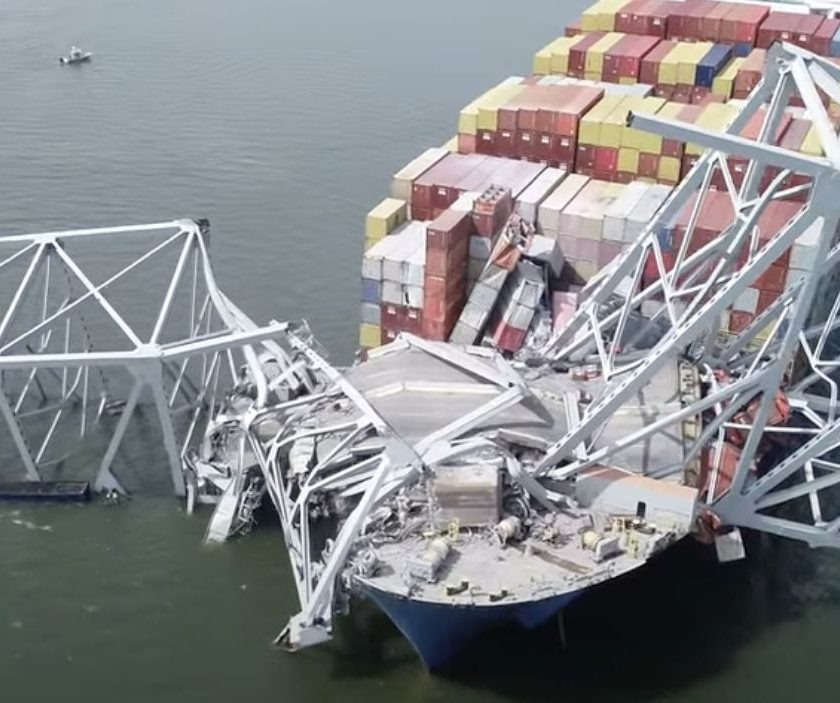First commercial ships sail through Baltimore’s deep-draft channel
NewsAfter over a month since the Baltimore bridge collapse, the first commercial vessels have started to move out of the Port of Baltimore via newly opened 35-feet channel.
The NTSB has revealed that the Dali containership carried 56 containers totaling 764 tonnes of hazardous materials, with some containers breached, prompting concerns over potential leakage, as authorities observed a sheen on the waterway.

In the ongoing investigation into the collapse of the Francis Scott Key Bridge in Baltimore on March 26, the US National Transportation Safety Board (NTSB) has boarded the Dali containership, the vessel involved in the incident.
According to recent updates, the NTSB has obtained the cargo manifest, and has identified 56 containers of hazardous materials onboard the Dali containership, totaling 764 tonnes.
These hazardous materials primarily consist of corrosives, flammables, and miscellaneous Class 9 hazardous materials, including lithium-ion batteries.
Of particular concern is the revelation that some of the hazardous material containers were breached during the collision. Authorities have observed a sheen on the waterway, indicating potential leakage.
NTSB Chair Jennifer Homendy said in a press briefing on Wednesday that the state and local authorities are now coordinating efforts to address the hazardous situation and mitigate any potential environmental impacts.
“We did board the vessel again today at 1:00 p.m., pretty much the entire team. We looked at the damage, we were able to take a look at peer protection and some of the damage to the containers and the bridge structure,” Homendy said.
“The National Transportation Safety Board boarded the vessel on Wednesday and collected documents, voyage data recorder extracts, and other evidence as part of their investigation. The NTSB also began interviewing crew members. We will continue to cooperate with investigators throughout this process,” Synergy Marine, operator of Dali, said in a statement.
“Our emergency response team is on the ground in Baltimore and is coordinating with officials on all stages of the recovery and remediation efforts. This includes participation in the Unified Command that has been established to provide information as it becomes available.”
As informed, the board has been able to confirm that 21 crew members were on board the vessel at the time of the accident plus two pilots.
Furthermore, an engineering group from NTSB was able to board the vessel as well and look into the bridge and the engine room looking for electronic components and potential downloadable recorders. The investigators have requested a number of documents from the crew including maintenance and inspection history, and have launched interviews with the crew.
The data recorder, also known as a VDR, was recovered on the morning of the accident by the US Coast Guard and provided to the NTSB. Approximately six hours of VDR data, spanning from midnight to 6:00 a.m., were made available to the NTSB, as explained by NTSB’s investigator in charge Marcel Muse.
Regulations require the VDR to record 30 days of history, and NTSB is currently in the process of obtaining additional data.
The VDR data consists of audio from the ship’s bridge and recordings from the ship’s VHF radios. The VDR recorded the ship’s departure from SeaGirt Marine Terminal at approximately 12:39, followed by its transit outbound in the Fort McHenry Channel and subsequent striking of the bridge, Muse said.
The data from the recordings indicates that the vessel suffered a blackout, causing the ship’s pilot to make a general VHF radio call for tugs in the vicinity to assist. The pilot ordered the Dali to drop the port anchor and additional steering commands. Shortly after, the pilot informed over radio that the Dali had lost all power and was approaching the bridge.
Around this time, data from Maryland Transportation Authority (MDTA) shows that that duty AER radioed two of their units already on scene due to construction on the bridge, ordering them to close traffic on the bridge. All lanes were subsequently shut down by MDTA.
From approximately 01:29 and 33 seconds, the VDR audio recorded sounds consistent with the collision of the bridge, Muse concluded, adding that the data will be reviewed.
Based on the latest update from the authorities, two bodies have been recovered from the water, CNN reports, indicating that these are the construction workers who fell into the water following the collision. Previous reports indicated that the collision has claimed the lives of six construction workers.
By subscribing you will have: